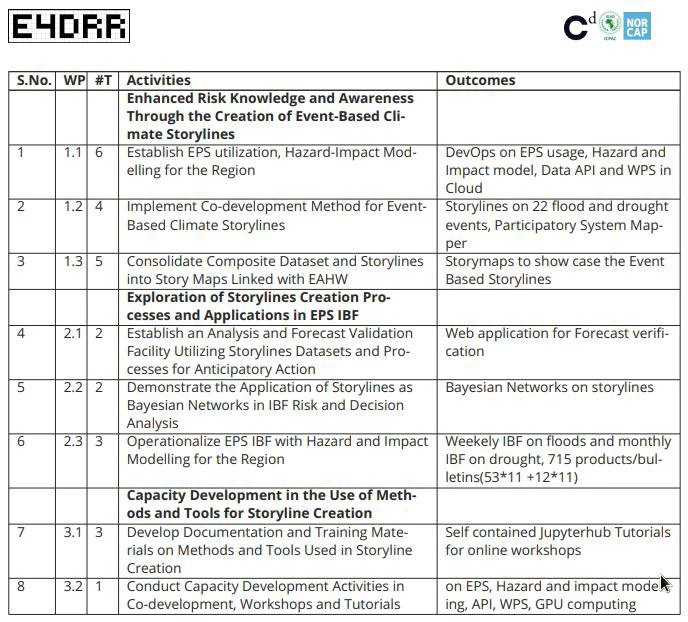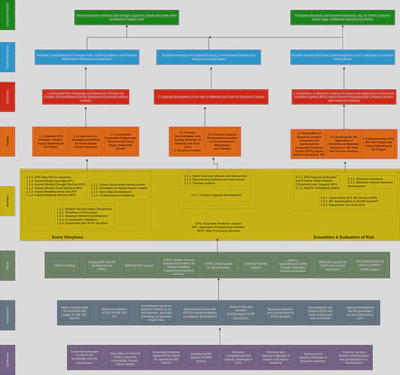Concept Note- E4DRR

Theory of Change

Activites of project:
Outcome 1. Enhanced Risk Knowledge and Awareness Through the Creation of Event-Based Climate Storylines
Work package 1 Establish Hazard and Impact Modelling for the Region: Setting up of hazard and impact modelling for the region
Activity 1.1.1 EPS Data API for storylines
- Organize and implement cost-effective programming routines for Ensemble Prediction System (ERA5 and GEFS) to be used for storylines creation as an Application Programming Interface (API).
Activity 1.1.2 Hazard Models Input Data API
- Collect static data related to parsimonious hazard models along with dynamic input data as an Application Programming Interface (API).
Activity 1.1.3 Hazard Models Drought DevOps WPS
- Set up the hazard model for Drought (CWALID) for validation and training schemes for operational purposes on cloud computing as a Development Operations (DevOps) Web Processing Services (WPS).
Activity 1.1.4 Hazard Models Flood DevOps WPS
- Set up the hazard model for flood (RIM2D) for validation and training schemes on GPU hardware and for operational purposes on cloud computing with Web Processing Services (WPS).
Activity 1.1.5 Impact Modeling Input Data API
- Collect static data required for impact calculations in CLIMADA, including exposure data, vulnerability defined in terms of impact functions, and hazard model outputs as an Application Programming Interface (API).
Activity 1.1.6 Impact Modeling DevOps WPS
- Set up the CLIMADA impact calculation tool using the hazard model outputs as input as a Development Operations (DevOps) Web Processing Services (WPS).
Work package 2 Implement Co-development Method for Event-Based Climate Storylines: Implement a co-development method for event-based climate storylines
Activity 1.2.1 Collect Documented Hazard Data and select events
- Collect available documented hazard datasets related to flood and drought disasters in the 11 East African countries for the period 2000-2024. Select 11 flood and 11 drought events for each country in EAHW.
Activity 1.2.2 Simulation of Hazard-Impact models
- Perform the hazard and impact modeling for the selected events using observed weather conditions as references for factual storylines based on documented hazards.
Activity 1.2.3 Story Map Development
- Design and develop story maps based on the reference storylines datasets.
Activity 1.2.4 Co-production Initiatives
- Conduct preliminary coproduction activities to scope and select representative events for drought and flood in the respective countries.
Work package 3 Consolidate Composite Dataset and Storylines into Story Maps Linked with EAHW: Consolidate the composite dataset and storylines as story maps and link with East Africa Hazard Watch (EAHW) web application
Activity 1.3.1 Multiple Simulations of Hazard-Impact Models
- Run the hazard and impact models in storylines mode for each selected event and obtain counterfactual initiation data from the rainfall forecast members of the EPS.
Activity 1.3.2 Storylines Organization in Story maps
- Organize the outputs of the hazard and impact models into storylines by extending the story maps from WP2 and link them with EAHW.
Activity 1.3.3 Bayesian Network Development
- Develop causal and Bayesian networks to represent the storylines, along with a web interface for coproduction.
Activity 1.3.4 Co-production Validation
- Conduct a second-stage coproduction process to validate and optimize the storylines, utilizing the Bayesian network web interface.
Activity 1.3.5 Experiment Gen AI for event-based climate storylines
- Explore the role of Generative AI Large Language Models (LLMs/chatGPT) in Bayesian and causal network creation and provide chat support with storylines narrative.
Outcome 2: Exploration of Storylines creation processes and applications in Ensemble Prediction System (EPS) Impact-Based Forecasting (IBF)
Work package 4 Establish an Analysis and Forecast Validation Facility Utilizing Storylines Datasets and Processes for Anticipatory Action: Develop analysis and forecast validation facility utilizing storyline dataset and processes for anticipatory action
Activity 2.1.1 Ensemble Prediction System (EPS) forecast verification and Extreme Value Analysis (Thresholds and Triggers) WPS
- Utilize the EPS used for storylines, GEFS for flood and SEAS5 for drought, their last 20 years hindcast for extreme value analysis on cloud computing as a Development Operations (DevOps) Web Processing Services (WPS).
Activity 2.1.2 Web interface for Anticipatory Action
- Following anticipatory action analysis routines on extreme value analysis for thresholds, forecast verification to set triggers utilizing impact data from storylines. Provide an analytical platform in a web interface through a Jupyter notebook-based setup.
Work package 5 Demonstrate the Application of Storylines as Bayesian Networks in IBF Risk and Decision Analysis
Activity 2.2.1 Storylines Synthesis
- Synthesize the storylines into a single Bayesian network for use in IBF.
Activity 2.2.2 Bayesian Network Backend Development
- Develop backend code for real-time EPS data download for flood and drought, operationalize semi-automated hazards and impact modeling, and perform risk and decision analysis.
Work package 6 Operationalize EPS IBF with Hazard and Impact Modelling for the Region Operationalize EPS IBF with hazards and impact modeling for the region
Activity 2.3.1 Cloud-native EPS IBF DevOps WPS
- Set up programming routines for interoperable data consumption and dissemination of project datasets, following the EPS IBF routines in cloud-native operations (CNO) and Analysis Ready, Cloud Optimized data formats (ARCO) as a Development Operations (DevOps) Web Processing Services (WPS).
Activity 2.3.2 IBF dissemination in EAHW layer/API
- Create a web application that shows backend processes with integration on Bayesian networks for operational Early Warning Early Action (EWEA) IBF, including workflow visualization for auditability of evidence for non-public operation center consumption. End product from IBF workflow in ICPAC climate services and EAHW dissemination in Application Programming Interface (API).
Activity 2.3.3 Experiment generative AI for EPS
- Explore the application of Generative AI (cGAN) in bias correction and downscaling of EPS data in an operational setup.
Outcome 3: Capacity Development in the Use of Methods and Tools for Storyline Creation
Work package 7 Develop Documentation and Training Materials on Methods and Tools Used in Storyline Creation Activities Prepare documentation and training materials on methods and tools used in storyline creation
Activity 3.1.1 Open Sourcing the software programs used for storylines tools and methods
- Open source the scripts and methodology for hazard modeling, impact estimation, Bayesian networks, operational downloading of EPS, story maps, interactive Bayesian networks.
Activity 3.1.2 Documentation on the software programs used for storylines tools and methods
- Create documentation for hazard modeling, impact estimation, Bayesian networks, operational downloading of EPS, story maps, interactive Bayesian Networks.
Activity 3.3.3 Tutorials on storylines tools and methods
- Tutorial development on hazard modeling, impact estimation, Bayesian networks, EPS in Jupyter notebooks.
Work package 8 Conduct Capacity Development Activities in Co-development, Workshops, and Tutorials Capacity development activities in co-development, workshops, and tutorials
- Activity 3.2.1 Conduct Capacity Development
- Conduct workshops and tutorials for capacity development by utilizing the ongoing activities at ICPAC and along with co-development events.